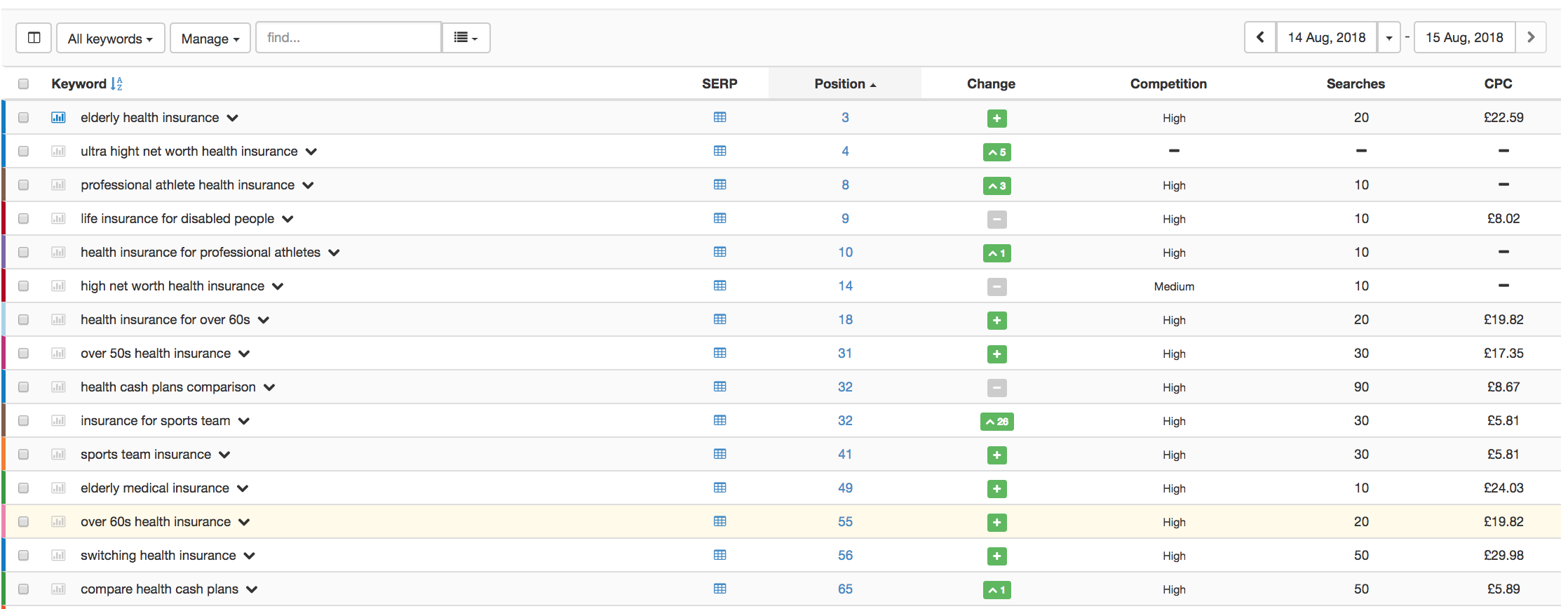On August 1 2018, Google rolled out a new algorithm search update, targeting broad searches across the globe.
This was the third algorithm update of the year, although many professionals in the SEO community have called this the biggest update since Penguin in 2012.
This week we released a broad core algorithm update, as we do several times per year. Our guidance about such updates remains the same as in March, as we covered here: https://t.co/uPlEdSLHoX
— Google SearchLiaison (@searchliaison) August 1, 2018
The algorithm update was picked up by all search monitoring tools as we saw a spike around the beginning of August and continued fluctuations for around one week.
SERP metrics
Advanced web rankings
Which sectors were impacted the most?
Research by Sistrix highlighted that the industries affected the most were ‘Your Money or Your Life,’ known as YMYL for short, which relates to the health and finance sectors, followed by eCommerce sites. Companies that saw notable drops included Pandora (-28%) My Protein (-24%) and Wales NHS (-18%).
Which SEO techniques were penalized and rewarded?
Whilst Google has not disclosed much information on the features of this algorithm update, the SEO forums and communities have been exchanging their thoughts and have highlighted the following factors:
- Mobile first-index
- Content and on-site linking
- Site speed.
What you can do to stay on top
Google has responded to queries on twitter by saying that ‘you should not do anything’ if you have been penalized and ‘there is no quick fix.’ But if you have been stung, why suffer from worse search results and less traffic? We highlight some key pointers below:
Mobile first: Mobile first-indexing is now fully under way, and those websites that do not have a mobile version, are not responsive or have a separate mobile site – will now face the music.
A number of sites have been complaining this month about not ranking for their brand name – however, this has coincided by not having a mobile version of their website.
In addition to a simple mobile design, mobile-friendly sites can maximize their results under Google’s mobile-first index by:
- Having clear information above the fold (whether it is an h1 tag or call to action button)
- Not hiding their content – whilst most desktop content is hidden on a mobile, this is still very important and should still be included. Accordion tabs can be a neat way of presenting this.
- Not covering up content with pop ups – so for cookie consent or GDPR opt-ins, you can effectively place them on the bottom of the screen, rather than as a pop up.
Content: In a world where content is king, Google has hinted for website content have expertise, authority and trust, known as (E-A-T). This is particularly relevant for the “Your Money, Your Life’ industry of health and money – where they would like medical information to be distributed by professors and doctors, rather than bloggers gaming the SEO system.
As the story goes, typing your health symptoms into Google can fill you with paranoia and anxiety – but a shift towards more authoritative content should make this a thing of the past.
But how can Google tell if an article about diabetes, cancer or disease is written by an expert or not? Whilst there are not any ‘quick fixes,’ it is common sense that bloggers are more likely to reference other websites more, since they are basing their writing on other opinions. When compared to a legitimate medical professional, they are simply writing their opinion without needing to reference.
In the case of health insurance comparison website MediCompare, they have historically used bloggers to ramp up their content and when the algorithm hit, their rankings fell like a stone.
However, a removal of all their external links, an increase in internal links and removing of heavy content, showed a recovery within 48 hours:
1st – 12th August
13th – 15th August
Speed: Site speed and loading time have been on Google’s radar for years and while it has always been a ranking factor, this is now crucial for good results. Previously we might have seen sites ranking at position 1 despite poor site speed, but this may no longer be the case.
Subsequently, SEOs and designers should now look at building websites with site speed in mind and simple ways to do this include browse caching, compressing images to below 100kb and compressing code where possible. Useful tools to assess your site speed include GTmetrix and of course, Googles Pagespeed Insights.
Overall, it appears the algorithm update is geared towards content being more authoritative and by providing users a better experience on mobile and with faster loading times across all devices. This certainly makes SEO harder than before – as ranking a site with a basic design and adding content is becoming a thing of the past. Whilst the health industry was clearly the biggest target in this algorithm update, SEO professionals must truly stay on top of the game. Otherwise we could find this algorithm update having a significant impact on all other industries and changing the face of SEO as we know it.
from SEO – Search Engine Watch https://ift.tt/2OGR7cq
via IFTTT





No comments:
Post a Comment